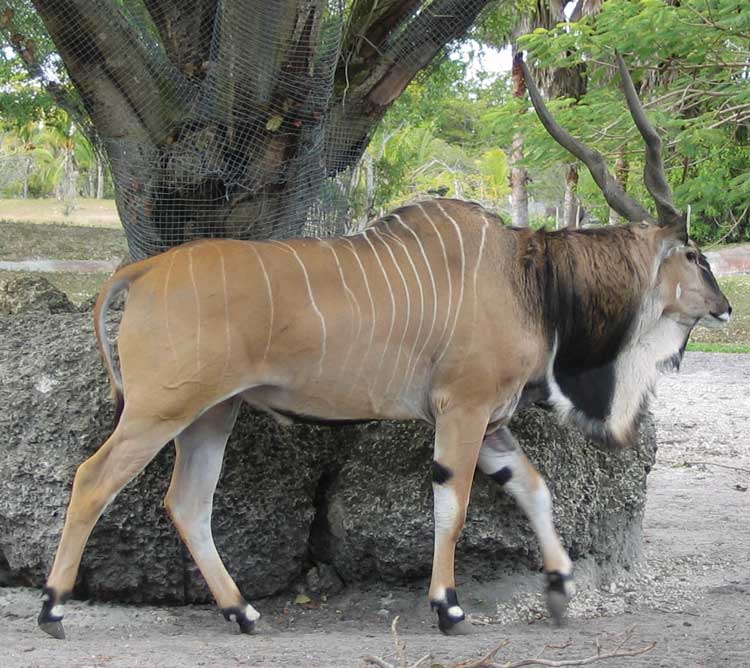
Taurotragus derbianus (Information about this image)
Superregnum: Eukaryota
Cladus: Opisthokonta
Regnum: Animalia
Subregnum: Eumetazoa
Cladus: Bilateria
Cladus: Nephrozoa
Cladus: Deuterostomia
Phylum: Chordata
Subphylum: Vertebrata
Infraphylum: Gnathostomata
Superclassis: Tetrapoda
Classis: Mammalia
Subclassis: Theria
Infraclassis: Placentalia
Superordo: Cetartiodactyla
Ordo: Artiodactyla
Subordo: Ruminantia
Familia: Bovidae
Subfamilia: Bovinae
Genus: Taurotragus
Species: Taurotragus derbianus
Name
Taurotragus derbianus (Gray, 1847)
References
* Taurotragus derbianus on Mammal Species of the World.
* Mammal Species of the World: A Taxonomic and Geographic Reference, 2 Volume Set edited by Don E. Wilson, DeeAnn M. Reeder
Vernacular names
Česky: Antilopa Derbyho
English: Giant eland
Magyar: Óriás jávorantilop
Nederlands: Reuzenelandantilope
日本語: ジャイアントイランド
Polski: Oreas
Türkçe: Dev boğa antilobu
The giant eland (Taurotragus derbianus also known as the Lord Derby eland) is an open forest savannah antelope. It is found in Central African Republic, Sudan, Cameroon and Senegal. There are two subspecies: the endangered T. d. derbianus, found in Senegal's Niokolo-Koba National Park, and the low risk T. d. gigas, found in Central Africa, especially in Cameroon and the Central African Republic.
Characteristics
Giant eland are typically between 220–290 cm (7.2–9.5 ft) in length, stand approximately 150 to 175 cm (4.9 to 5.74 ft) at the shoulder, and weigh 440–900 kg (970–2,000 lb). Despite its common name, it is of very similar size to the common eland. The smooth coat is reddish-brown to chestnut, usually darker in males than females, with several well-defined vertical white stripes on the torso. A crest of short black hair extends down the neck to the middle of the back, and is especially prominent on the shoulders. The slender legs are slightly lighter on their inner surfaces, with black and white markings just above the hooves. There are large black spots on the upper forelegs. The bridge of the nose is charcoal black, and there is a thin, indistinct tan-coloured chevron between the eyes. The lips are white, along with several dots along the jaw-line. A pendulous dewlap, larger in males then females, originates from between the jowls and hangs to the upper chest, with a fringe of hair on its edge. The tail is long, and ends with a dark tuft of hair. Both sexes have tightly spiralled horns, which are relatively straight. In males the horns form a wide "V" and can grow to 120 cm (3.9 ft) in length, slightly longer than on females.
Ontogeny and reproduction
Gestation period: 9 months
Young per birth: 1
Weaning: After 6 months.
Sexual maturity: Females at 15–36 months, males at 4–5 years.
Lifespan: Up to 25 years.
Ecology and behavior
Primarily nocturnal, giant elands are highly nomadic, with large home ranges and seasonal migration patterns. During the day, herds often rest in sheltered areas. A gregarious species, giant eland herds usually consist of twenty or more animals and do not disband during the wet season, suggesting that social rather than ecological factors are responsible for herding. There is no evidence of territoriality, and males rarely display aggression, even during the breeding season. Giant eland are alert and wary, making them difficult to approach and observe. They move quickly, running at over 70 km/h (43 mph), and despite their size are exceptional jumpers, easily clearing heights of 1.5 m (4.9 ft). Giant eland live in open forest and savannah where they eat grass, leaves, and branches. Their primary predators are the lion, spotted hyena and perhaps leopards.
Distribution and subspecies
Broad-leafed savanna and glades in two isolated pockets in central and western Africa, which correspond to the two recognized subspecies, the Western giant eland (T. d. derbianus) and the Eastern giant eland or Lord Derby´s eland (T. d. gigas). The Western giant eland is largely restricted to Niokolo Koba National Park in Senegal. The Eastern giant eland is found in several reserves, for example in Bénoué National Park, Faro National Park and Bouba Njida National Park in Cameroon and in Manovo-Gounda St. Floris National Park in the Central African Republic.[1]
References
^ a b IUCN SSC Antelope Specialist Group (2008). Tragelaphus derbianus. In: IUCN 2008. IUCN Red List of Threatened Species. Downloaded on 29 March 2009. Database entry includes a brief justification of why this species is of least concern.
Happold, D. C. D. 1987. The Mammals of Nigeria. Oxford: Clarendon Press.
IEA (Institute of Applied Ecology) 1998. Taurotragus derbianus. In African Mammals Databank - A Databank for the Conservation and Management of the African Mammals Vol 1 and 2. Bruxelles: European Commission Directorate. Available online at http://gorilla.bio.uniroma1.it/amd/amd333b.html
Kingdon, J. 1997. The Kingdon Field Guide to African Mammals. Academic Press, London and New York: NaturalWorld.
Nowak, R. M. [editor]. 1991. Walker's Mammals of the World (Fifth Edition). Baltimore: The Johns Hopkins University Press.
Grubb, Peter (16 November 2005). "Order Artiodactyla (pp. 637-722)". In Wilson, Don E., and Reeder, DeeAnn M., eds. Mammal Species of the World: A Taxonomic and Geographic Reference (3rd ed.). Baltimore: Johns Hopkins University Press, 2 vols. (2142 pp.). ISBN 978-0-8018-8221-0. OCLC 62265494.
Project Giant Eland Conservation. Available online at http://www.gianteland.com/
Retrieved from "http://en.wikipedia.org/"
All text is available under the terms of the GNU Free Documentation License

